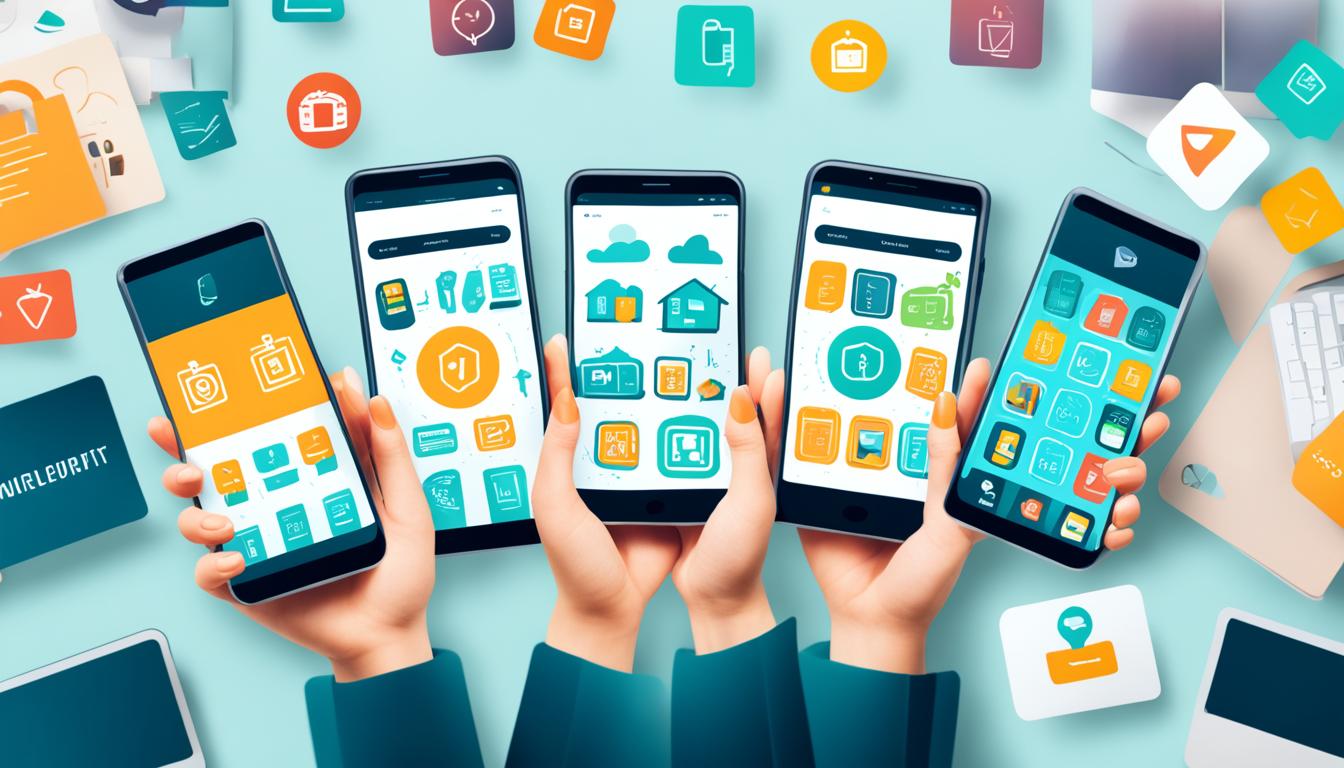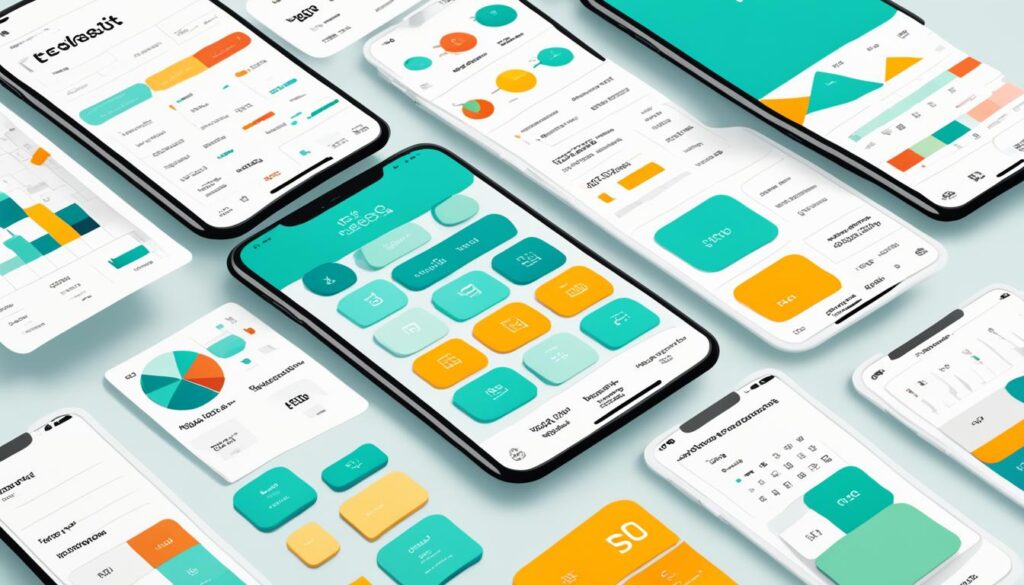In today’s fast-paced world, lifestyle mobile apps are more popular than ever. They offer tools and services to make daily routines better. If you’re an entrepreneur or a business looking to grow, it’s key to know how to make a lifestyle mobile app.
This guide will cover the main steps. We’ll talk about finding out who your app is for, figuring out costs, and adding important features. It’s all about making your app a hit.
Table of Contents
Key Takeaways
- Understand the target audience and their needs to create a successful lifestyle mobile app
- Identify key features and functionalities that align with user preferences
- Estimate development costs based on factors such as platform, complexity, and integration requirements
- Prioritize user experience design to ensure an engaging and intuitive app
- Incorporate essential features like personalization, social integration, and seamless data sync
Introduction to Lifestyle Mobile App Development
The lifestyle app market has grown a lot in recent years. More people use digital tools to make their lives better and stay healthy. These apps help with health, fitness, productivity, and more, making life easier and helping users reach their goals.
Lifestyle apps have many benefits for users and developers alike. They offer personalized solutions to improve work-life balance, health, finance, and hobbies. This makes the market a great chance for entrepreneurs and developers.
Key trends are changing the lifestyle app industry. These trends include using data, AI, and AR, and making apps more personal. By following these trends, developers can make apps that stand out and meet user needs.
| Benefits of Lifestyle Apps | Lifestyle App Trends |
|---|---|
|
|
“The lifestyle app market has become a go-to destination for individuals seeking digital tools to simplify and enrich their daily lives.”
Developers can make innovative apps by understanding lifestyle app benefits and trends. This way, they can meet the needs of lifestyle-conscious consumers.
Understanding Your Target Audience
To make a lifestyle mobile app a hit, you need to really get to know your audience. Look into their income, job, family, education, language, where they live, age, gender, and what apps they like. Also, check out their tech use, social networks, and the devices they prefer. Knowing how they shop, make decisions, and what drives them can help you reach and connect with your ideal users.
Identifying User Needs and Preferences
Creating an app that hits the mark means understanding what your users want and like. Use surveys, interviews, and focus groups to find out their problems and what they value most. This will guide you in making an app that fits their lifestyle perfectly.
Conducting Market Research
It’s also key to look at what others in the lifestyle app space are doing. Check out your competitors and see what users think of them. Look for areas where your app can offer something new and better. Keep updating your user profiles and listen to feedback to keep improving your app.
“Understanding your target audience is the key to developing a successful lifestyle mobile app that truly resonates with your users.”
By mixing user insights with market analysis, you can make an app that not only meets your audience’s needs but also shines in a crowded market. This approach ensures your app is focused on users, innovative, and likely to succeed.
Ideation and Planning Phase
Creating a successful lifestyle mobile app starts with a strategic plan. This phase is key for setting up your app’s features, functionality, and direction. By defining your app’s main parts, you make sure it meets your audience’s needs and likes.
Defining App Features and Functionality
Your app’s core is in its features and functionality. To make an app that connects with users, research their problems, likes, and goals. This helps you develop unique features that meet their needs.
Begin by listing possible app features, thinking about both must-haves and nice-to-haves. Lifestyle app features could include:
- Personalized health and wellness tracking
- Intuitive scheduling and time management tools
- Seamless integration with wearable devices
- Curated content and recommendations for a healthier lifestyle
- Social networking and community-building features
- Gamification elements to encourage user engagement and habit formation
When planning your app development, focus on features that match your audience’s app idea validation and offer the most value. This way, you build a focused, user-focused app that shines in the crowded market.
“The key to developing a successful lifestyle app is to deeply understand your target audience and design features that address their unique needs and pain points.”
| Feature | Description | Potential User Benefits |
|---|---|---|
| Personalized Health Tracking | Allows users to monitor their physical activity, sleep patterns, nutrition, and other health metrics | Helps users make informed decisions about their well-being and achieve personal health goals |
| Intuitive Scheduling | Provides a centralized calendar and task management system to help users organize their daily routines | Improves productivity, reduces stress, and enables better work-life balance |
| Lifestyle Content Curation | Delivers personalized recommendations for healthy recipes, fitness routines, mindfulness practices, and other lifestyle-related content | Inspires users to adopt healthier habits and discover new ways to enhance their overall quality of life |
Choosing the Right Development Approach
Choosing the best way to make a lifestyle mobile app is key. You can pick from native, cross-platform, or hybrid development, each with its own pros and cons. Knowing the differences helps match your project’s goals, budget, and timeline with the right strategy.
Native Development
Native development means making an app just for one platform, like iOS or Android. It uses the device’s full power for better performance and a smooth user experience. But, it takes more time and money because you need different codes for each platform.
Cross-Platform Development
With cross-platform development, you make one code work on many platforms. Tools like React Native and Flutter help developers create apps that feel native but cost less to make. The downside is, these apps might not be as good as ones made just for one platform.
Hybrid Development
Hybrid development mixes native and cross-platform methods. Hybrid apps use web tech (HTML, CSS, JavaScript) and a native shell to reach device features. This way, you get a good mix of efficiency and native-like performance.
When picking a development method for your app, think about who will use it, what it needs to do, how fast you need it, and your budget. This helps you choose the best approach for your app’s needs and success.
“The right development approach can make or break the success of your lifestyle app. It’s crucial to weigh the pros and cons of each option to find the perfect fit for your project.”
Estimating the Cost of Lifestyle App Development
Creating a top-notch lifestyle mobile app takes a big investment. It’s key to know what affects the cost for planning and managing your project. From the start to the app’s launch, many things can change the total cost. Good planning helps keep your project on schedule.
Factors Influencing Development Costs
When planning your budget for a lifestyle app, several things matter. Let’s look at some main factors that can change the lifestyle app development cost:
- App Complexity and Features – The more complex and the more features your app has, the more it will cost. Cutting down on features can help save money.
- Development Platform – Your choice of iOS, Android, or a cross-platform solution affects your budget. Each has different needs and ways of developing.
- Design and User Experience – A well-designed, easy-to-use app is key to success, but it also adds to the cost.
- Ongoing Maintenance and Updates – Keeping your app updated and fixing user issues costs money. Make sure to include this in your budgeting for lifestyle app plan.
| Feature | Estimated Cost Range |
|---|---|
| Basic Lifestyle App | $15,000 – $30,000 |
| Advanced Lifestyle App with Integration | $30,000 – $60,000 |
| Custom Lifestyle App with Unique Features | $60,000 – $100,000+ |
Think about these factors and match your development plans with your budget. This way, you can make a successful and affordable lifestyle mobile app that your audience will love.
Designing the User Experience
Making your lifestyle mobile app stand out is crucial for its success. Good UI/UX design makes your app easy to use, look good, and fit into your users’ daily lives. It’s all about making things simple and enjoyable for them.
UI/UX Design Best Practices
To make your lifestyle app user experience amazing, follow these top tips for UI/UX design for lifestyle apps:
- Know your audience: Create an interface that feels right at home with your users.
- Keep it simple: A clean design lets users easily see what’s important.
- Make it work for everyone: Your app should be easy to use on different devices and for all users.
- Use visual cues: Elements, fonts, and colors should guide users smoothly through the app.
- Easy to navigate: A clear and consistent way to move around the app is key.
- Listen to your users: Use feedback to make your app better and fix any issues.
By using these UI/UX design for lifestyle apps tips, you’ll create an app design for user engagement that really draws in your audience. This will help keep them coming back for more.
“The best design is invisible. It’s only when it’s not working that you notice it.”
How to Develop a Lifestyle Mobile App
Creating a successful lifestyle mobile app takes a strategic plan. It covers many stages, from planning to maintenance. Each step is key to making sure your app meets your audience’s needs and stands out.
Here’s a step-by-step guide on the lifestyle app development process:
- Define Your App’s Purpose and Features: Identify the problem your app will solve and the features that add value. This focus helps you make a user-centered app.
- Conduct Market Research: Look at the competition, understand what users want, and find what makes your app unique. This helps you stand out in the app development lifecycle.
- Design the User Experience: Make a UI that’s easy to use and fits your app’s brand. Use good UI/UX design to make sure users enjoy using your app.
- Develop the App: Choose the right technology to build your steps to build a lifestyle app. Make sure it works well, performs well, and is secure.
- Test and Optimize: Test your app to find and fix problems. Keep improving it with user feedback and data to make users happier.
- Deploy and Market: Put your app in the app stores, make it easy to find, and market it well to get more users.
- Maintain and Update: Keep an eye on what users say, use data to improve, and add new stuff to keep your app fresh.
By following this detailed lifestyle app development process, you can make a lifestyle app that users love. It will help you succeed in the app market for a long time.
| Key Stages | Description |
|---|---|
| Planning and Ideation | Define the app’s purpose, features, and target audience. |
| Design and Development | Create the user interface, implement the app’s functionality, and ensure quality and security. |
| Testing and Optimization | Conduct thorough testing and continuously improve the app based on user feedback. |
| Launch and Marketing | Deploy the app, optimize it for app stores, and execute a marketing strategy to drive adoption. |
| Maintenance and Updates | Monitor user engagement, address issues, and introduce new features to keep the app relevant. |
“The key to successful lifestyle app development is to prioritize user needs and preferences throughout the entire process, from ideation to deployment and beyond.”
Integrating Essential Features
Creating a hit lifestyle mobile app means picking and blending key features that meet your audience’s needs. These features boost user interaction and make your app stand out in the crowded lifestyle app market.
Must-Have Features for Lifestyle Apps
For essential features for lifestyle apps, some elements are crucial. Top popular lifestyle app features include:
- Options for personalizing the app’s look, settings, and what content to show
- Tools for tracking and analyzing lifestyle aspects like fitness, sleep, or budgeting
- Easy linking with other devices, services, or platforms for a unified experience
- Features for sharing with friends, family, or groups
- Elements that make using the app fun, like challenges, rewards, or tracking progress
These core functionality for lifestyle apps aim to empower users, improve their lifestyle management, and build community and engagement. By thoughtfully adding these features, you can make a lifestyle mobile app that really speaks to your audience and stands out in the market.
“Successful lifestyle apps are those that seamlessly integrate essential features, providing users with a personalized and enriching digital experience that complements their daily routines.”
Testing and Quality Assurance
Creating a strong and dependable lifestyle mobile app needs a detailed testing and quality assurance (QA) process. This important step makes sure your app works well, gives users a great experience, and fixes any bugs before it comes out.
The lifestyle app testing phase covers many key parts. These include checking how the app works, how easy it is to use, and what users think of it. By carefully checking the app’s features, design, and how it performs, you can spot and fix any quality assurance for lifestyle apps issues. This makes the app more stable and reliable.
Fixing bugs and making the app better is a big part of testing. This means looking for any technical problems, design mistakes, or issues with how the app feels to users. Then, you make the needed changes to make sure the app is smooth and fun to use.
| Testing Type | Objective |
|---|---|
| Functional Testing | Verifying that all app features and functionalities work as intended |
| Usability Testing | Evaluating the app’s ease of use and user-friendliness |
| User Acceptance Testing | Ensuring the app meets the target audience’s needs and expectations |
By focusing on detailed lifestyle app testing and quality assurance, you can make a lifestyle mobile app that really connects with your audience. This leads to more user engagement and success.
App Store Optimization and Marketing
After your lifestyle mobile app is ready, focus on app store optimization and marketing strategies for a great launch. This guide helps you optimize your app’s listing and use promotional tactics. It also covers a full marketing plan to draw in and keep users.
Strategies for Successful App Launch
Here are some tips for a successful app launch:
- App Store Optimization (ASO): Make your app’s title, description, keywords, and visuals stand out. Use keyword research, create eye-catching screenshots, and write a compelling description.
- Promotional Campaigns: Use social media, email, and influencers to create excitement and boost downloads. Offer discounts or special deals to encourage people to try your app.
- Leveraging App Directories: List your app on trusted directories and review sites to increase visibility and trust. This helps potential users find and read good reviews about your app.
- Engaging User Reviews: Answer both positive and negative reviews to show you care about customer satisfaction. Address concerns and feedback. Positive reviews help with app store optimization and getting more users.
By using these app launch strategies, you can promote your lifestyle app well. This will help it get noticed and used more by your target audience.
| Tactic | Description | Key Benefits |
|---|---|---|
| App Store Optimization | Make your app’s listing better with title, keywords, and visuals | More visibility, better search spots, more downloads |
| Promotional Campaigns | Use social media, email, and influencers to spread the word | More users, brand awareness, better engagement |
| App Directories | Put your app on trusted review sites and directories | Better online presence, more credibility, chance for featured spots |
| User Review Engagement | Reply to all reviews, good or bad | Happy customers, higher ratings, more reviews |
Monetization Models for Lifestyle Apps
Creating a successful lifestyle mobile app means having a solid plan for making money. You want to keep users engaged and happy. Think about how your app can make money through different ways, like in-app purchases, subscriptions, and ads.
In-app purchases are a common way for lifestyle apps to make money. Users can buy extra features, premium content, or virtual items. This works well for apps that give personalized advice, special content, or tools to help with daily tasks.
Subscriptions are another good choice. Users pay a regular fee to get everything the app offers. This is great for apps that help with fitness, meal planning, or managing money. By having loyal users who pay for your app, you can build a strong business model.
Advertising can also bring in money, especially if your app has lots of users. You can use different types of ads, like banners or sponsored content. Ads can add to your income without making the app hard to use. This helps you make more money from your lifestyle apps.
When picking a way to make money, think about who uses your app, what it offers, and what others are doing. By understanding what your users like, you can choose the best way to make money. Or, you might use a mix of methods to keep your app successful.
Maintaining and Updating Your App
Creating a lifestyle mobile app is a continuous task. It needs ongoing lifestyle app maintenance, updates, and improvements. To keep your app interesting and useful, it’s important to listen to what users say, fix bugs, and add new features. These updates should meet the changing needs of users and market trends.
Keeping up with app updates and improvements is key to keeping users happy and successful in the long run. By checking user reviews, tracking how people use the app, and getting feedback, you can find areas to improve. This helps you decide which features to add next.
- Fix bugs and security issues quickly to keep the app smooth for users.
- Add new features and functions based on what users want and what’s popular.
- Make the app faster and easier to use to keep users happy.
Offering ongoing support for lifestyle apps helps build a strong brand and trust with users. Hire a support team to help with user questions, fix problems, and keep in touch with your app’s community.
“Continuous improvement is better than delayed perfection.” – Mark Twain
By focusing on lifestyle app maintenance, app updates and improvements, and ongoing support, your lifestyle mobile app will stay useful and essential for users. This approach will help your app grow and succeed over time.
Conclusion
Creating a successful lifestyle mobile app takes a strategic plan. You need to know your audience well, come up with a great app idea, and make sure it has strong features. This way, you can make an app that really helps people in their daily lives.
Important steps include doing deep market research, focusing on making the app easy to use, adding key features, and finding ways to make money. Also, testing the app well, making it easy to find in app stores, and keeping it updated are key for success.
This guide has given you the key knowledge to make your lifestyle app a reality. Remember, the app world is always changing. So, be ready to adapt and meet the changing needs of your users. With these tips, your app can become a must-have for people, helping them live their best lives.














